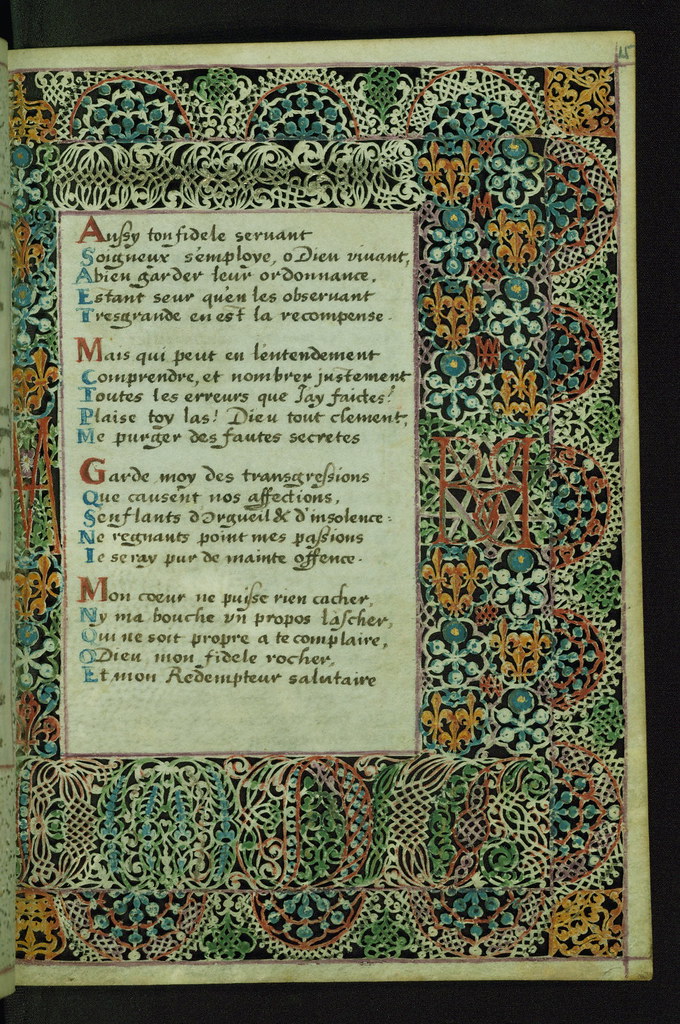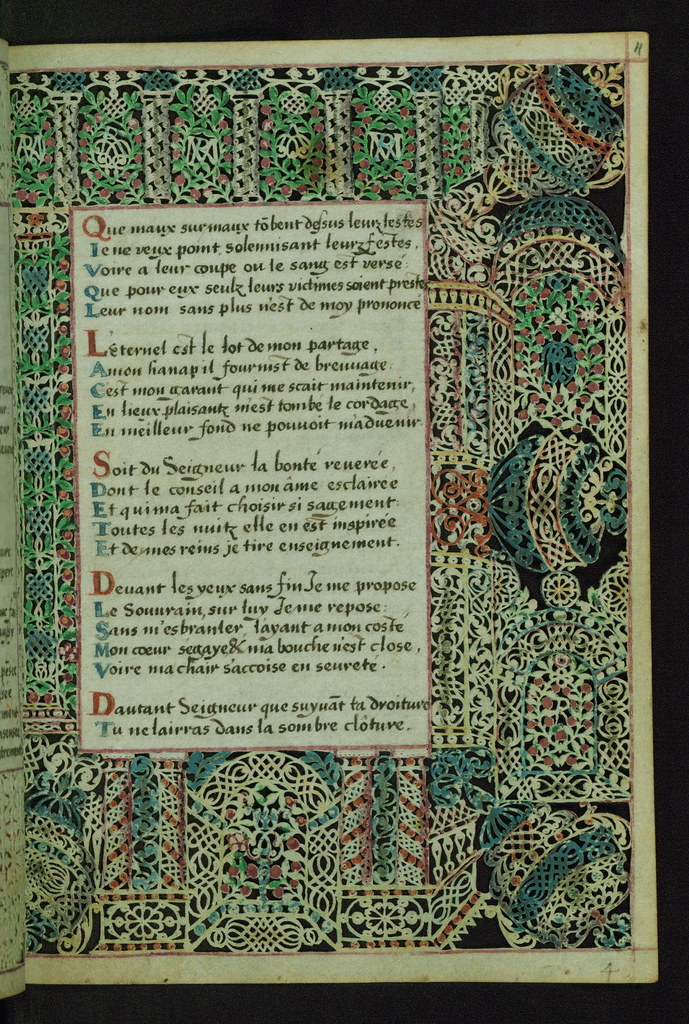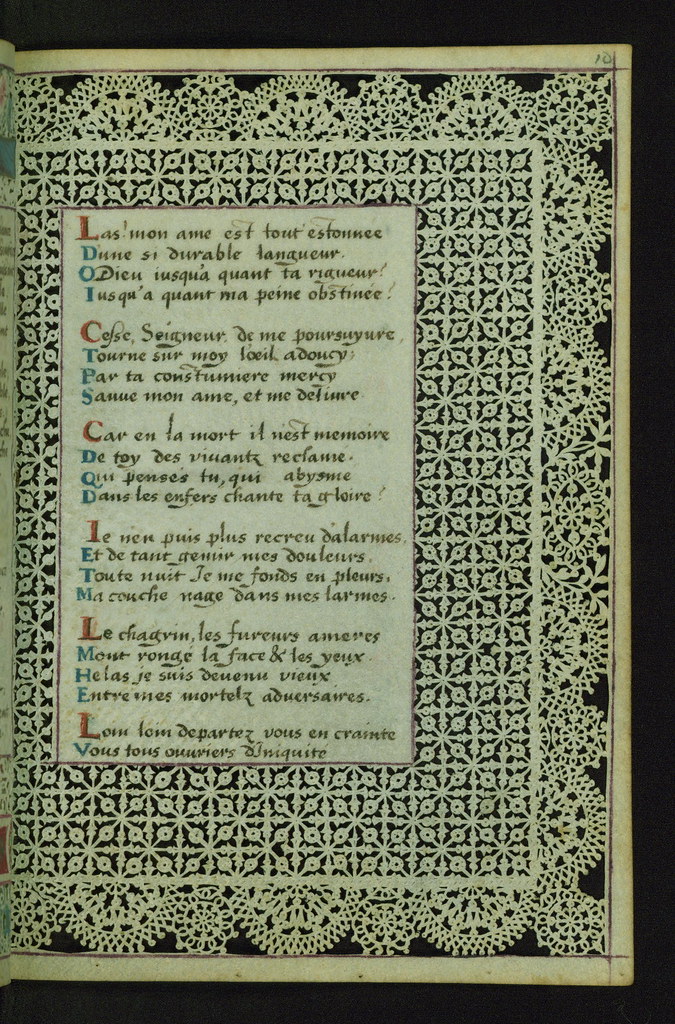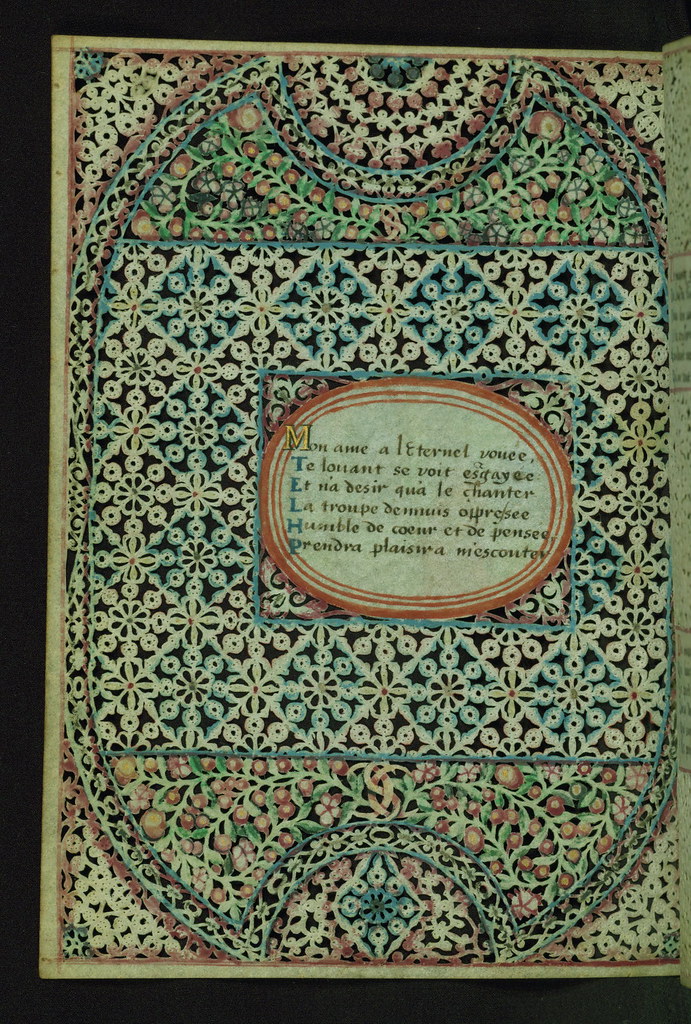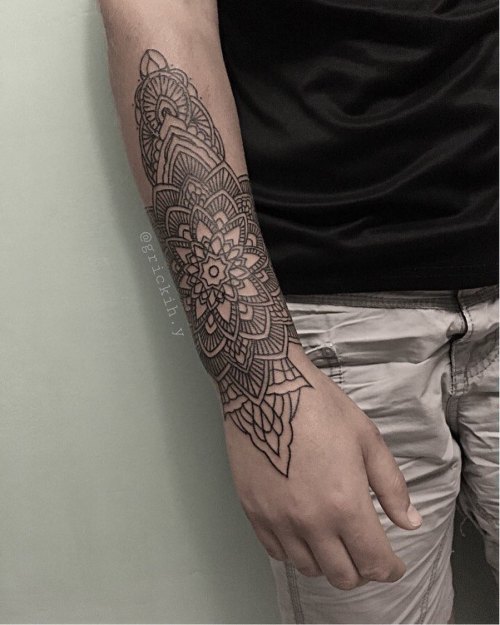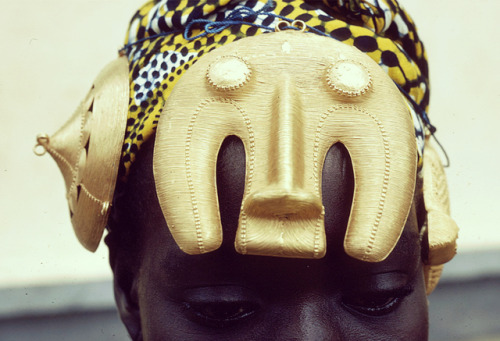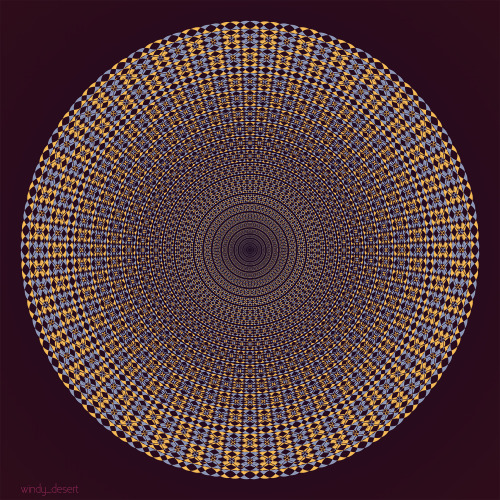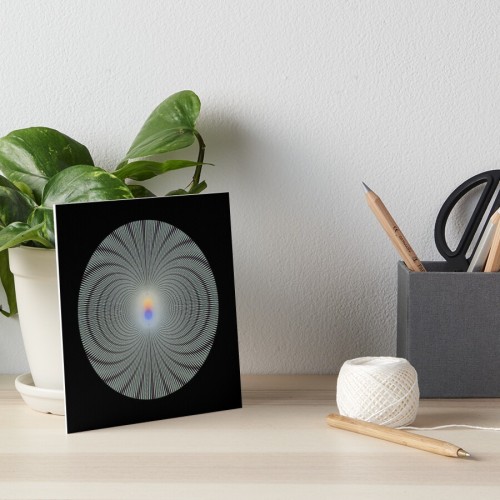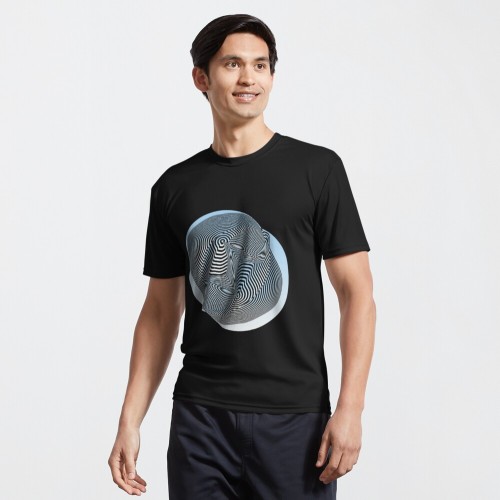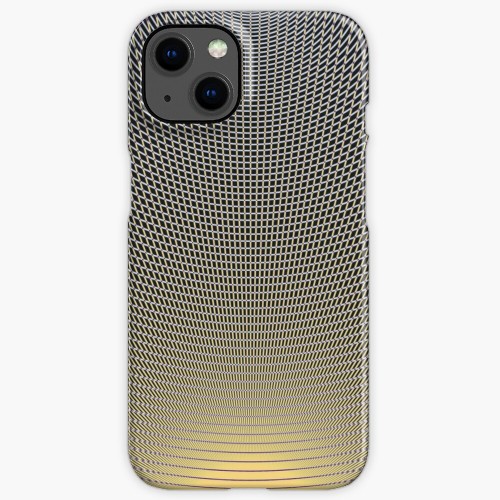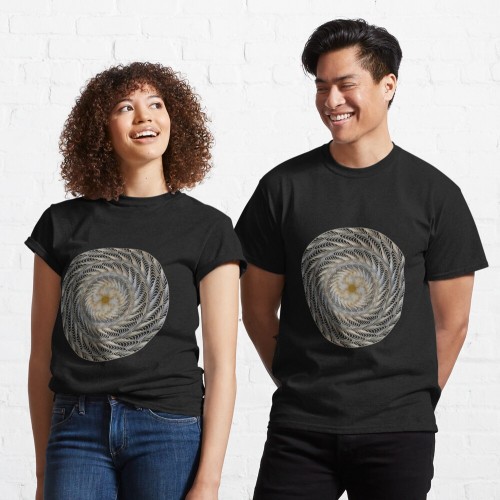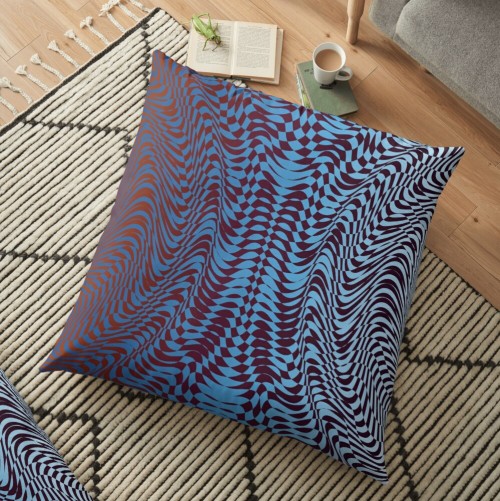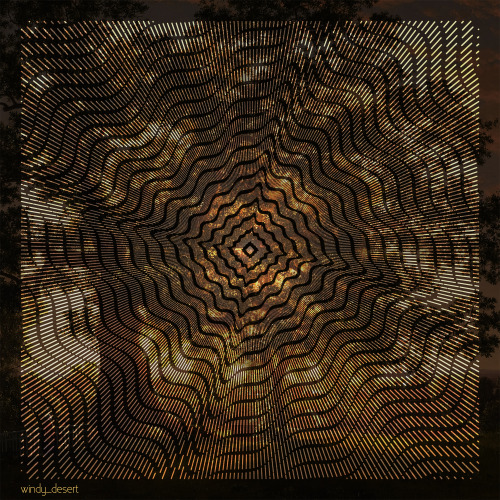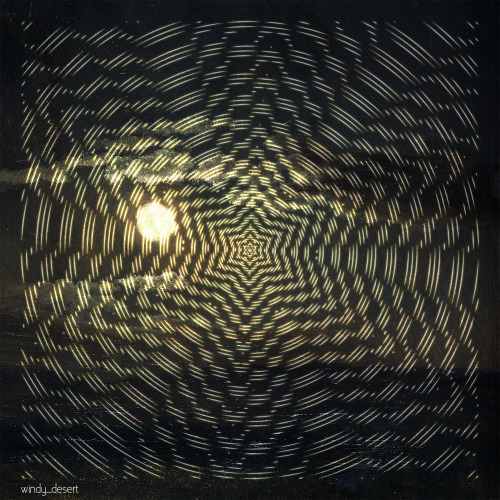#ornament
Lace Book of Marie de’ Medici, Lace margins, Walters Manuscript W.494, Folio 15r by Walters Art Museum
Via Flickr:
This Prayerbook was made for Marie de’ Medici in the second quarter of the seventeenth century. Beyond its provenance as a personal book owned by the famous queen, it is exceptional for its intricately cut borders, which transform the parchment margins into lace. This effect was created using a technique known as “canivet,” in which a small knife was used to cut ornate patterns into paper or parchment. An art form that flourished originally among nuns in France, Germany, and the Netherlands beginning in the sixteenth century, it was employed to exceptional effect in several manuscripts connected with Marie de’ Medici. The Walters manuscript, made for her while she was regent of France, and wife of King Henry IV, contains twenty-eight miniatures, including original religious imagery as well as several later additions: a gouache portrait of the elderly queen, and nine small miniatures produced in Bruges ca. 1450 by an artist influenced by the Eyckian and Gold Scrolls styles prevalent at the time; the coat-of-arms of Marie de Medici, as well as her monogram. The Walters manuscript retains its original binding composed of mosaic inlays in green and black leather, as well as fine gilt pointillé foliate tooling, and a replica of the binding was created by Léon Gruel for Henry Walters on one of his seventeenth-century printed books (92.467) that also connects to Marie de’ Medici. All manuscript images and descriptions were created and are provided through Preservation and Access grants awarded to the Walters Art Museum by the National Endowment for the Humanities, 2008-2014. Access a complete set of high-resolution archival images of this manuscript for free on the Digital Walters at www.thedigitalwalters.org/Data/WaltersManuscripts/html/W494/
Lace Book of Marie de’ Medici, Transfiguration, Walters Manuscript W.494, fol. 13r by Walters Art Museum
Via Flickr:
This Prayerbook was made for Marie de’ Medici in the second quarter of the seventeenth century. Beyond its provenance as a personal book owned by the famous queen, it is exceptional for its intricately cut borders, which transform the parchment margins into lace. This effect was created using a technique known as “canivet,” in which a small knife was used to cut ornate patterns into paper or parchment. An art form that flourished originally among nuns in France, Germany, and the Netherlands beginning in the sixteenth century, it was employed to exceptional effect in several manuscripts connected with Marie de’ Medici. The Walters manuscript, made for her while she was regent of France, and wife of King Henry IV, contains twenty-eight miniatures, including original religious imagery as well as several later additions: a gouache portrait of the elderly queen, and nine small miniatures produced in Bruges ca. 1450 by an artist influenced by the Eyckian and Gold Scrolls styles prevalent at the time; the coat-of-arms of Marie de Medici, as well as her monogram. The Walters manuscript retains its original binding composed of mosaic inlays in green and black leather, as well as fine gilt pointillé foliate tooling, and a replica of the binding was created by Léon Gruel for Henry Walters on one of his seventeenth-century printed books (92.467) that also connects to Marie de’ Medici. All manuscript images and descriptions were created and are provided through Preservation and Access grants awarded to the Walters Art Museum by the National Endowment for the Humanities, 2008-2014. Access a complete set of high-resolution archival images of this manuscript for free on the Digital Walters at www.thedigitalwalters.org/Data/WaltersManuscripts/html/W494/
Lace Book of Marie de’ Medici, Lace margins, Walters Manuscript W.494, Folio 11r by Walters Art Museum
Via Flickr:
This Prayerbook was made for Marie de’ Medici in the second quarter of the seventeenth century. Beyond its provenance as a personal book owned by the famous queen, it is exceptional for its intricately cut borders, which transform the parchment margins into lace. This effect was created using a technique known as “canivet,” in which a small knife was used to cut ornate patterns into paper or parchment. An art form that flourished originally among nuns in France, Germany, and the Netherlands beginning in the sixteenth century, it was employed to exceptional effect in several manuscripts connected with Marie de’ Medici. The Walters manuscript, made for her while she was regent of France, and wife of King Henry IV, contains twenty-eight miniatures, including original religious imagery as well as several later additions: a gouache portrait of the elderly queen, and nine small miniatures produced in Bruges ca. 1450 by an artist influenced by the Eyckian and Gold Scrolls styles prevalent at the time; the coat-of-arms of Marie de Medici, as well as her monogram. The Walters manuscript retains its original binding composed of mosaic inlays in green and black leather, as well as fine gilt pointillé foliate tooling, and a replica of the binding was created by Léon Gruel for Henry Walters on one of his seventeenth-century printed books (92.467) that also connects to Marie de’ Medici. All manuscript images and descriptions were created and are provided through Preservation and Access grants awarded to the Walters Art Museum by the National Endowment for the Humanities, 2008-2014. Access a complete set of high-resolution archival images of this manuscript for free on the Digital Walters at www.thedigitalwalters.org/Data/WaltersManuscripts/html/W494/
Lace Book of Marie de’ Medici, Lace margins, Walters Manuscript W.494, Folio 10r by Walters Art Museum
Via Flickr:
This Prayerbook was made for Marie de’ Medici in the second quarter of the seventeenth century. Beyond its provenance as a personal book owned by the famous queen, it is exceptional for its intricately cut borders, which transform the parchment margins into lace. This effect was created using a technique known as “canivet,” in which a small knife was used to cut ornate patterns into paper or parchment. An art form that flourished originally among nuns in France, Germany, and the Netherlands beginning in the sixteenth century, it was employed to exceptional effect in several manuscripts connected with Marie de’ Medici. The Walters manuscript, made for her while she was regent of France, and wife of King Henry IV, contains twenty-eight miniatures, including original religious imagery as well as several later additions: a gouache portrait of the elderly queen, and nine small miniatures produced in Bruges ca. 1450 by an artist influenced by the Eyckian and Gold Scrolls styles prevalent at the time; the coat-of-arms of Marie de Medici, as well as her monogram. The Walters manuscript retains its original binding composed of mosaic inlays in green and black leather, as well as fine gilt pointillé foliate tooling, and a replica of the binding was created by Léon Gruel for Henry Walters on one of his seventeenth-century printed books (92.467) that also connects to Marie de’ Medici. All manuscript images and descriptions were created and are provided through Preservation and Access grants awarded to the Walters Art Museum by the National Endowment for the Humanities, 2008-2014. Access a complete set of high-resolution archival images of this manuscript for free on the Digital Walters at www.thedigitalwalters.org/Data/WaltersManuscripts/html/W494/
Lace Book of Marie de’ Medici, John the Baptist baptizing Christ, Walters Manuscript W.494, fol. 8r by Walters Art Museum
Via Flickr:
This Prayerbook was made for Marie de’ Medici in the second quarter of the seventeenth century. Beyond its provenance as a personal book owned by the famous queen, it is exceptional for its intricately cut borders, which transform the parchment margins into lace. This effect was created using a technique known as “canivet,” in which a small knife was used to cut ornate patterns into paper or parchment. An art form that flourished originally among nuns in France, Germany, and the Netherlands beginning in the sixteenth century, it was employed to exceptional effect in several manuscripts connected with Marie de’ Medici. The Walters manuscript, made for her while she was regent of France, and wife of King Henry IV, contains twenty-eight miniatures, including original religious imagery as well as several later additions: a gouache portrait of the elderly queen, and nine small miniatures produced in Bruges ca. 1450 by an artist influenced by the Eyckian and Gold Scrolls styles prevalent at the time; the coat-of-arms of Marie de Medici, as well as her monogram. The Walters manuscript retains its original binding composed of mosaic inlays in green and black leather, as well as fine gilt pointillé foliate tooling, and a replica of the binding was created by Léon Gruel for Henry Walters on one of his seventeenth-century printed books (92.467) that also connects to Marie de’ Medici. All manuscript images and descriptions were created and are provided through Preservation and Access grants awarded to the Walters Art Museum by the National Endowment for the Humanities, 2008-2014. Access a complete set of high-resolution archival images of this manuscript for free on the Digital Walters at www.thedigitalwalters.org/Data/WaltersManuscripts/html/W494/
Lace Book of Marie de’ Medici, Lace margins, Walters Manuscript W.494, Folio 6v by Walters Art Museum
Via Flickr:
This Prayerbook was made for Marie de’ Medici in the second quarter of the seventeenth century. Beyond its provenance as a personal book owned by the famous queen, it is exceptional for its intricately cut borders, which transform the parchment margins into lace. This effect was created using a technique known as “canivet,” in which a small knife was used to cut ornate patterns into paper or parchment. An art form that flourished originally among nuns in France, Germany, and the Netherlands beginning in the sixteenth century, it was employed to exceptional effect in several manuscripts connected with Marie de’ Medici. The Walters manuscript, made for her while she was regent of France, and wife of King Henry IV, contains twenty-eight miniatures, including original religious imagery as well as several later additions: a gouache portrait of the elderly queen, and nine small miniatures produced in Bruges ca. 1450 by an artist influenced by the Eyckian and Gold Scrolls styles prevalent at the time; the coat-of-arms of Marie de Medici, as well as her monogram. The Walters manuscript retains its original binding composed of mosaic inlays in green and black leather, as well as fine gilt pointillé foliate tooling, and a replica of the binding was created by Léon Gruel for Henry Walters on one of his seventeenth-century printed books (92.467) that also connects to Marie de’ Medici. All manuscript images and descriptions were created and are provided through Preservation and Access grants awarded to the Walters Art Museum by the National Endowment for the Humanities, 2008-2014. Access a complete set of high-resolution archival images of this manuscript for free on the Digital Walters at www.thedigitalwalters.org/Data/WaltersManuscripts/html/W494/
Lace Book of Marie de’ Medici, Flight into Egypt, Walters Manuscript W.494, fol. 6r by Walters Art Museum
Via Flickr:
This Prayerbook was made for Marie de’ Medici in the second quarter of the seventeenth century. Beyond its provenance as a personal book owned by the famous queen, it is exceptional for its intricately cut borders, which transform the parchment margins into lace. This effect was created using a technique known as “canivet,” in which a small knife was used to cut ornate patterns into paper or parchment. An art form that flourished originally among nuns in France, Germany, and the Netherlands beginning in the sixteenth century, it was employed to exceptional effect in several manuscripts connected with Marie de’ Medici. The Walters manuscript, made for her while she was regent of France, and wife of King Henry IV, contains twenty-eight miniatures, including original religious imagery as well as several later additions: a gouache portrait of the elderly queen, and nine small miniatures produced in Bruges ca. 1450 by an artist influenced by the Eyckian and Gold Scrolls styles prevalent at the time; the coat-of-arms of Marie de Medici, as well as her monogram. The Walters manuscript retains its original binding composed of mosaic inlays in green and black leather, as well as fine gilt pointillé foliate tooling, and a replica of the binding was created by Léon Gruel for Henry Walters on one of his seventeenth-century printed books (92.467) that also connects to Marie de’ Medici. All manuscript images and descriptions were created and are provided through Preservation and Access grants awarded to the Walters Art Museum by the National Endowment for the Humanities, 2008-2014. Access a complete set of high-resolution archival images of this manuscript for free on the Digital Walters at www.thedigitalwalters.org/Data/WaltersManuscripts/html/W494/
ornament #illustration #drawing #illustration #draw #sketch #tattoodesing #flashworkers #blackworkers #btattooing #onlyblackart #tattooworkers #equilattera #thinkbeforeuink #futurehouse #fatumalism #tattrx #grickih #graphics #skinartmag #oneline #fasionart #linework #dotwork #spbtattoo #nikolaevtattoo #fatumalism #futurism #ornament #blackwork #geometrip #abstractart
https://www.instagram.com/p/CDjE6lfJxoM/?igshid=1pw0ff135i459
Post link

tea presso’s Photo: Starbucks | tumblr
checkers wave dos
One of those ornaments that appear by accident after a dozen failed attempts to create something palatable to the eye.
● follow me on insta and get prints of my art ●
Post link
You can support me, an independent artist from Russia, by purchasing any of my prints or merch from my REDBUBBLE STORE! Every dollar/euro/tögrög received is getting me closer to moving out of this country lmao. Thank you and peace!
Post link
curve rays a.psd
Background painting by Frederic Edwin Church.
● follow me on insta and get prints of my art ●
Post link
curve rays b.psd
Background painting by Albert Bierstadt .
● follow me on insta and get prints of my art ●
Post link



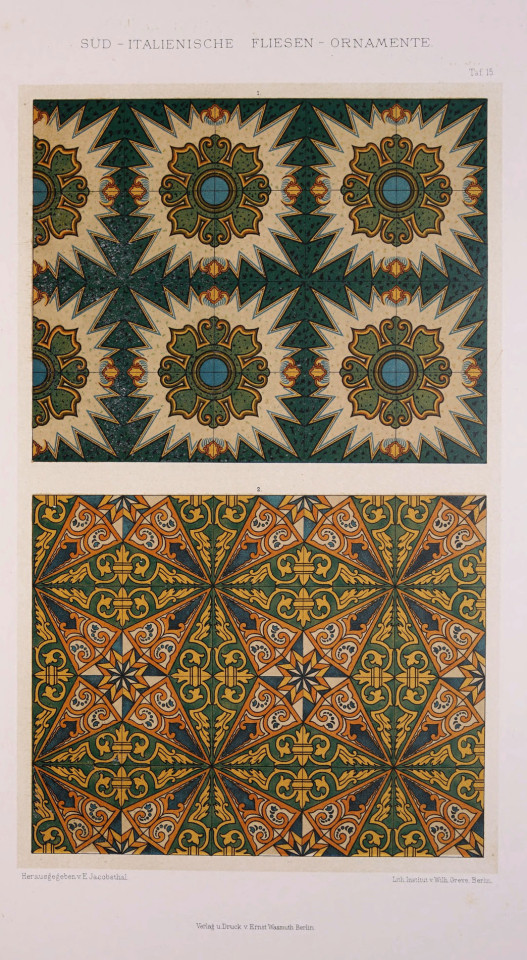


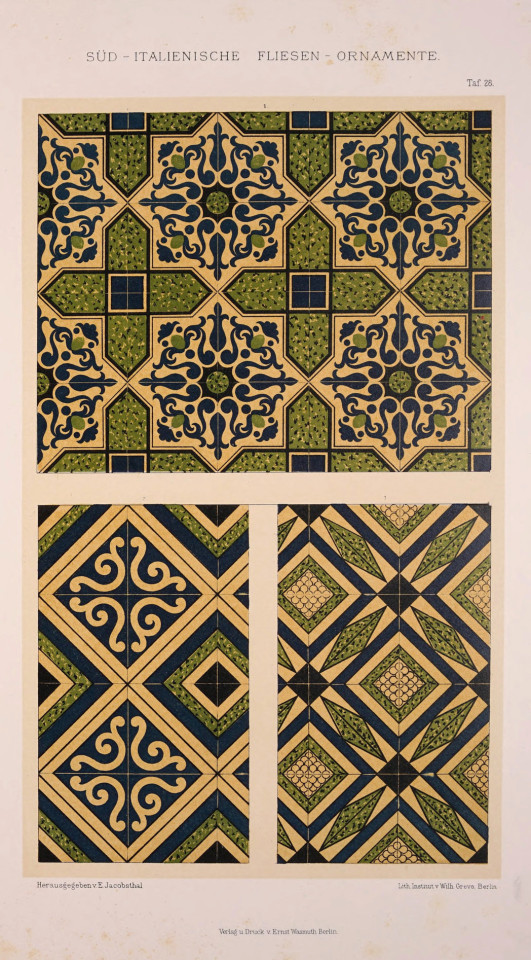
Johann Eduard Jacobsthal, “Süd-italienische Fliesen-Ornamente”, South italian tile ornaments, 1886. Chromolithography. Published by Ernst Wasmuth, Tübingen, Germany. Source: archive.org. Via frizzifrizzi
+ 1063 stitches
.
.
.
.
#crossstitch #crossstitching #crossstitchersofinstagram #stitches #ornament #xstitch #xstitching #embroidery #embroideryart #lovexstitch #crossstitchaddiction #needlework #crossstitcher #handmade #embroiderersofinstagram #hoopart #embroideryart
https://www.instagram.com/p/CT4r9CHMXvn/?utm_medium=tumblr
Post link

